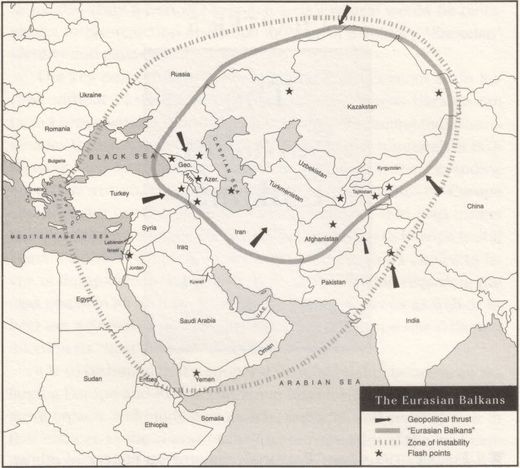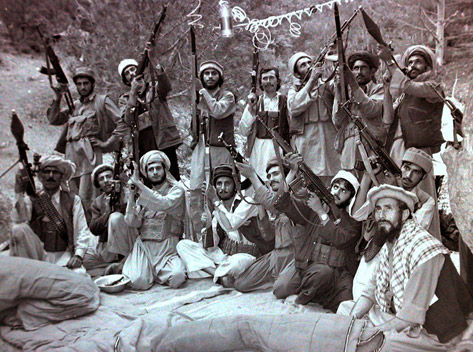A global shift in US strategy is currently underway, with America transitioning from the 'world policeman' to the Lead From Behind mastermind. This fundamental shift essentially entails the US moving from a majority forward-operating military to a defensive stay-behind force. Part of this transformation is the reduction of the conventional military and its replacement with special forces and intelligence recruits. Private military companies (PMCs) are also occupying a higher role in the US' grand strategy. Of course, it is not to say that the US no longer has the capability or will to forward advance - not at all - but that the evolving US strategy prefers more indirect and nefarious approaches towards projecting power besides massive invasions and bombing runs. In this manner, it is following the advice of Sun Tzu who wrote that "supreme excellence consists in breaking the enemy's resistance without fighting." The outcome is a mixture of Color Revolutions, unconventional warfare, and mercenary interventions that avoids the direct use of US combat troops while relying heavily on regional allies' proxy involvement. This results in the promotion of American policy via oblique methods and the retention of relative plausible deniability. Importantly, the absence of conventional forces is thought to reduce the risk of a direct confrontation between the US and Russia, China, and Iran, the primary targets of these proxy wars.
The Eurasian-wide plan of strategic destabilization and state fracturing owes its genesis to Zbigniew Brzezinski and his Eurasian Balkans concept. The US is flexible in practicing this concept, and it does not meet a dead end if the destabilization encounters an obstacle and cannot be advanced. Should this occur, as it has in Ukraine, Syria and Iraq, and possibly soon in the South China Sea, the stratagem evolves into maximizing the chaos within the launch pad states that are positioned on the doorsteps of the Eurasian Powers. The idea is to create 'black holes' of absolute disorder in which Moscow, Beijing, and Tehran are "damned if they do, damned if they don't" intervene. Ideally, the US prefers that its intended targets are sucked into a quagmire that bleeds them dry and destabilizes them at home, per the example of the Soviet-Afghan War which Brzezinski conspired over 30 years ago. Moving away from the expansive Eurasian Balkans and reverting to the roots of 'Afghan anarchy' is the nature of the Reverse Brzezinski, and it poses the ultimate dilemma-like trap for the Eurasian Powers.
Comment: This strategy which, no doubt, comes from some of the most twisted minds currently occupying this planet, hasn't worked so well against Russia at all, they terribly underestimated Putin. Wishful thinking will get you every time.
The Afghan Prototype:
The US' experience in training and arming the Mujahideen to bring about and manage the Soviet-Afghan War can be seen as the first foray into the Lead From Behind strategy. The US worked hand-in-hand with Pakistan and other Muslim states to sow the seeds of chaos in Afghanistan (including the creation of the international mercenary organization Al Qaeda), thus creating a strategic destabilization so tempting that the Soviet Union could not resist the urge to intervene. This was the goal all along and it was a resounding success. It also the pinnacle of Cold War-era proxy warfare that meshed perfectly with the international balance of power at the time. It was so successful that it is credited as one of the contributing factors to the dissolution of the Soviet Union in 1991. This altered the global power balance and resulted in the US' unipolar moment. During this period of time, the Afghan Lead From Behind prototype was no longer seen as necessary because the US now had the power, will, and opportunity to project power directly and forcefully all across the world.
The Unipolar Moment of Shock and Awe:
Drunk with power after emerging victorious from the Cold War, the US began a spate of military interventions beginning with the First Gulf War. Although marketed as a multilateral operation, the US was the primary participant in the warring coalition. Within a few years, the US was then bombing Serbian positions in Bosnia before initiating a unilateral NATO war in Serbia's Kosovo province. It was the bombing of Serbia that awakened Russian decision makers to the need to defend their country from future threats, thus beginning a commitment towards modernizing its defense industry in order to deter a direct American/NATO attack against Russian interests. Nonetheless, this did not result in an immediate change, and in the meantime, the US' power had yet to climax.
After the 9/11 terrorist attacks, the US undertook military operations and a subsequent occupation of Afghanistan, a country situated halfway across the world and near the Heartland of Eurasia. This massive expansion of American military might and reach inside the continent was unprecedented, yet even that did not mark the highlight of the post-Cold War era. The epitome of the unipolar moment was actually the 2003 Shock and Awe campaign in Iraq. During that time, the US massively bombarded Iraq in a show of force definitely made to remind the rest of the world of the US' sole superpower status. It also deployed incredible amounts of troops and weaponry into the Mideast. Ironically enough, the subsequent financial and opportunity costs of the war and occupation would play a strong role in decreasing American power and allowing other countries such as Russia and China to catch up in challenging and defending against the US within their own spheres of interest.

It was at the middle of the unipolar moment in 1997 that Brzezinski authored "The Grand Chessboard" in which he laid out the US' geostrategic priorities for Eurasia and how to best achieve them. He postulated that it was imperative for the US to retain a commanding influence over Eurasia, and that one of the best ways to do this was to prevent collusion between Russia and China. The strategic 'Balkanizing' of societies across the Eurasian landmass is a pivotal means of destabilizing the entire continent. If taken to its logical end, it is envisioned to create a tidal wave of ethnic, religious, and political anarchy that can crash into and dismember the diverse civilizations of Russia, China, and Iran. In some aspects, the US wars in Afghanistan and Iraq and their chaotic aftermath can be seen as following the philosophic dictates of this principle. The US has also historically undertaken regime change operations as a method of advancing continental destabilization and pushing Western power deeper into Eurasia.
Comment: Also, the whole ISIS situation can be seen as following the philosophic dictates of this principle.
Regime Change:
Regime change has always been a characteristic of American foreign policy, owing back to the covert overthrow of the Syrian government in 1949. Since then, it has been estimated that the CIA has overthrown or attempted to overthrow over 50 governments, although it has only admitted to 7 of them. Regime change can be either direct or indirect. Pertaining to the former, one can look at the examples of Panama in 1989 or Iraq in 2003, whereas the latter can be witnessed by the 1953 Iranian coup or the trail of Color Revolutions.
As can be evidenced from the recent Ukrainian coup, regime change today can be as cheap as only $5 billion, a fraction of the cost that it would have taken to directly overthrow Yanukovich and invade the country. Additionally, owing to international circumstances and the resurgence of Russian military might and will, it may not have been possible for the US to do so without risking a major war. Therefore, covert regime change operations are seen as preferable when the interests of other Great Powers are at stake. It is very important for the new leadership to have perceived legitimacy within the international community following the coup. Seeing as how Western democracy is viewed as a legitimate governing standard, pro-Western Color Revolutions are the optimal method of regime change among targeted states not currently practicing this form of government.
Color Revolutions:
Color Revolutions are outside-supported pro-Western coups. They specifically use the tools of social media and NGOs to infiltrate societies, increase their ranks, and expand their efficiency after the regime change operation has been commenced. Because they typically manipulate large groups of people, they create the illusion of a broad grassroots movement of disaffected masses rising up against a tyrannical dictatorship. This misleading perception enables the coup attempt to gain wide support and acceptance among the Western community, and it also denigrates the legitimate authorities that are trying to put down the illegal overthrow. The manipulation-prone masses are drawn to the street movements largely as a result of Gene Sharp's tactics, which adroitly seek to amplify social protest movements to their maximum possible extent.
Comment: Exactly what happened prior to the Ukrainian coup. The Western media went into overdrive to sell the narrative as stated above.
This new method of warfare is extremely effective because it presents a startling dilemma for the affected state - does the leadership use force against the civilian protesters (de-facto human shields unaware that they are being politically manipulated) in order to strike at the militant Right Sektor-esque core? And with the eyes of the Western media following the developments, can the government afford to be isolated from that community of nations if it legally defends itself? Thus, Color Revolutions present a strategic Catch-22 for the targeted government, and it is therefore not difficult to see why they had been deployed all across the post-Soviet space and beyond. They have replaced 'traditional' CIA coup action and have become the modus operandi of covert regime change.
Part II
Jun 23, 2014
Towards the Lead From Behind Strategy and Its Official Acceptance:
Conventional (forceful) regime change strategies (Panama, Afghanistan, Iraq) were possible in a unipolar world, but with the unipolar moment fading, the US has been compelled to revive the Lead From Behind template first flirted with during the Soviet-Afghan War. The first official indication that the US was moving towards this strategy was its behavior during the 2011 Libyan War, the first-ever use of the Lead From Behind moniker. This was followed by then-Secretary of Defense Robert Gates' final speech that summer, in which he implored NATO allies to do more to assist the US in tackling global challenges. It thus became clear that the US was no longer as enthusiastic about "going it alone" as it had been before, nor does it seem willing to pose the ultimatum of "you are either with us or against us."
Comment: By assisting the US with 'global challenges' he means, among other things, overthrowing governments, training mercenaries, spreading propaganda.
The indication that American power is relatively slipping vis-à-vis the other Great Powers was formally seconded by the National Intelligence Council in late 2012. In its "Global Trends 2030" publication, it writes about how the US will be "first among equals" because "the 'unipolar moment' is over, and 'Pax Americana' - the era of American ascendancy in international politics that began in 1945 - is fast winding down." Clearly, under such a competitive environment, aggressive unilateralism will be more difficult to deploy without risking collateral consequences. This further gave an added impulse to the Lead Form Behind strategy's implementation into mainstream American military planning.
Finally, President Obama institutionalized the Lead From Behind template when he spoke at West Point at the end of May. In his speech, he notable said that "America must lead on the world stage... but U.S. military action cannot be the only - or even primary - component of our leadership in every instance. Just because we have the best hammer does not mean that every problem is a nail." This has been interpreted as the US formally abandoning the unilateral 'go it alone' doctrine except under exceptional circumstances. At this point, it is evident that the US has definitively displayed its intention to trade the world policeman post for the Lead From Behind mastermind mantle. Further illustrating this point, the theater-wide social and political transformation that the US envisioned with the Arab Spring could not have succeeded with unilateral action. Therefore, the year 2011 represents the official end of the unipolar moment and the beginning of the Lead From Behind era, which is in and of itself the US military's adaptation to a multipolar world.
The Syrian and Ukrainian Improvisations:
Both Syria and Ukraine represent tactical improvisations of the Lead From Behind and Eurasian Balkans strategies. The resultant hybrid presents the first indication of what the US' new approach to warfare looks like.
Beginning with Syria, the US covert war there is part of its Arab Spring designs in transforming the region. Unlike Tunisia, Egypt, or Yemen, the Syrian authorities steadfastly resisted the Color Revolution attempt owing to remarkable popular support and legitimacy among the population. This presented a hurdle in implementing the exact Lead From Behind model that had just been rolled out in Libya (Color Revolutionaries aided by Western airstrikes). Whereas in Libya large segments of society were delicately held together by the personality and governing style of a single individual, in Syria the situation was altogether different. Syria has a civilizational identity, whereas Libya solely has a national identity (although Gaddafi was attempting to evolve this into a continental African-wide identity before he was overthrown and murdered). Nevertheless, because strong popular support made it extremely difficult to 'Balkanize' Syria in the same manner as it had Libya, the US had to improvise its strategy and adapt to this obstacle.
The US thus opted to Lead From Behind in an indirect way, helping to recruit, train, arm, and deploy Islamic-affiliated mercenaries into Syria. It uses Turkey as the regional delegate to Lead From Behind out of mutual self-interest. Ankara has ambitions of restoring the Ottoman Empire albeit in a refashioned form, and thus, it has been the US' most active ally in destabilizing Syria. When the Color Revolution/Lead Form Behind hybrid was evidently not enough to topple the Syrian government, the US then ramped up its unconventional warfare strategy there. Therefore, the contribution of the Syrian experience to the US' new war strategy has been that Western-trained mercenary groups are given an increased role in advancing on-the-ground objectives.
Comment: Here the US gave birth to its offspring ISIS, and they are now warning everyone just how bad these guys are and how much danger they pose, all to hide the fact that they created these terrorist organizations in the first place.
See: The Covert Origins of ISIS
This principle has been applied with mixed success in Ukraine following the coup against Yanukovich. Prior to that, the US had once more rolled out its Color Revolution/Lead From Behind hybrid, except in this case, Poland replaced Turkey as the regional hegemon destabilizing its neighbor. Regardless, there were many structural similarities, but unlike Assad who bravely resisted the external war being waged against him, Yanukovich quickly capitulated and was rapidly overthrown. At this point, the people of Crimea and Donbass resisted the coup-installed authorities and began to assert their human rights. While Crimea was successful in quickly reuniting with the Russian Federation (owing to its unique historical circumstances and demographics), Donbass has had to wage a lengthy struggle of self-determination. It is through this struggle that the US imported its Syrian strategy for deployment in Ukraine. Western mercenaries, CIA and FBI agents, military advisors, and over $50 million in funding was sent to the junta to aid in putting down the eastern rebellion. The fact that the improvisations learned during the Syrian destabilization are being repeated in another theater confirms that the US has now developed a new patterned approach to warfare.
The Reverse Brzezinski and the Eurasian Snares:
The covert wars being waged by the US in Syria and Ukraine are part and parcel of the larger Eurasian Balkans strategy. Ideally, the backroom logic was that the destabilizations would spread like wildfire in a parched forest and come to engulf Iran (from Syria and its mercenary spillover into Iraq) and Russia (from Ukraine). This wishful thinking was quickly derailed when Syria and the people of Crimea and Donbass resisted. By extension, Iran and Russia also worked to hedge their interests in their respective spheres, understanding that a success for US foreign policy there could pose an existential threat to their being. Thus, with the destabilization being relatively contained, the Reverse Brzezinski strategy was ushered in.
The US sought to capitalize off of the chaos present in Syria and Ukraine in order to create 'black holes' to suck in Iran and Russia. Scientifically speaking, a black hole is formed from a collapsed star, so the metaphor can quickly be transplanted to geopolitics when one looks at Balkanized chaos being formed from a collapsed state (or portions thereof). Syria has not collapsed, but parts of the country remain beyond the control of the legitimate government. It is Iraq that is approaching near-failed state status and whose problems can pose a dangerous threat to Iran. Likewise, Ukraine itself is a pseudo-failed state, and the events that have transpired there are of significant danger to Russia. In both cases, what has occurred is that black holes are forming in parts of Syria, most of Iraq, and Ukraine, and the gravitational pull of the destabilization and chaos there can quite easily suck in Iran and Russia. After all, Iran and Russia have legitimate national security interests that are endangered by the US-managed events going on nearby and the temptation may be too great for them to abstain from involvement there. This makes the situations in Syria/Iraq and Ukraine Eurasian snares meant to entrap Iran and Russia.
Russia and Iran were first targeted for the Reverse Brzezinski because the US already has significant infrastructure and influence in their neighborhoods (NATO and the Gulf bases). This makes it easier to manage such large-scale covert operations. A similar structure is not yet in place in Southeast Asia, but it may soon appear following the US' Pivot to Asia. The US does have such infrastructure and influence in Northeast Asia, but it is Southeast Asia which represents Beijing's soft underbelly of vulnerability. In the future, the US may use the lessons from Syria/Iraq and Ukraine to construct an even more alluring snare to entrap China, or it may be that if it succeeds in knocking Russia and Iran 'out of the game', an accommodation could potentially be made with China in order to cement it in a subservient position. Similarly, if the US can succeed in a large-scale destabilization of Central Asia following the Afghan withdrawal, then a mega-regional black hole may develop which would simultaneously suck in Russia, China, and Iran. This would be the coup de grace of American Eurasian planning and would represent the fulfilment of The Grand Chessboard's strategic objective.
Concluding Thoughts:

To accentuate the fact that this strategy is currently being employed by American decision makers, one must look no further than the case studies of Syria and Ukraine. These are the two battlegrounds that are at the forefront of this strategy's official 'coming out', and they also represent real-time testing grounds for this idea to become perfected. Recent statements illustrate that the US' primary goal is to lure Russia and Iran into the Eurasian snares of Ukraine and Syria/Iraq. Brzezinski himself has advised that the US directly arm the powers in Kiev in order to bunker down any 'invading' Russian forces that he is convinced are on hair's edge to storm across the border. Likewise, the US is now talking about 'cooperating' with Iran to defeat the Western-backed ISIL in Iraq. The thinking goes that American airstrikes would provide cover for Iranian Revolutionary Guard offensives (in coordination with the Iraqi Army), but in reality, what this amounts to is the US conditionally choosing when and where to insert itself in the battle (from afar) while the Iranians and Iraqi troops are used as cannon fodder on the ground. The offers of cooperation are nothing more than a feint to trick the Iranians into getting caught up in mission creep in Iraq. The "Iranian Reset" is just as fake as the US-Russian Reset - a deceptive trick to buy valuable time for setting up a strategic betrayal.
While the Eastern European and Mideast snares have already been deployed, the Asian version is still in development. The US must first complete its Pivot to Asia before it can comprehensively lay a trap for China, however, this doesn't mean that it hasn't already been testing various strategies. For example, the Vietnamese-Chinese South China Sea dispute continues to heat up, with accusations of aggressive behavior from both sides. The US is testing the waters over which Lead From Behind partner should be delegated the regional leader, and thus far, it appears as though Vietnam is at the forefront of successful anti-Chinese policy maneuvers. Nevertheless, because the Pivot to Asia is still in its infancy, this may change, and it is difficult to predict exactly how the Asian snare will look when it is finally deployed.
As a result of changing international circumstances,the US has conclusively moved away from its desire for large-scale military interventions in favor of covert paramilitary proxy wars. The appointment of Frank Archibald to head the CIA's National Clandestine Service (NCS) in 2013 is proof enough of the importance of paramilitary operations, regime change, and Color Revolutions in American strategy. Archibald was involved in the Bosnian Civil War and oversaw the first Color Revolution in Serbia in 2000. When an expert in paramilitary campaigns and Color Revolutions, incidentally the individual who carried out the first successful one in history, is elevated to the top of the NCS, then any and all Color Revolutionary movements should rightfully be suspected of being CIA operations, as should any paramilitary campaign that is detrimental to Russian, Chinese, or Iranian interests. With the US reducing its dependency on conventional conflict in order to follow Sun Tzu's advice of defeating an enemy without directly fighting them, America's new approach to warfare has become more nefarious.
The godfather of the Soviet-Afghan War has returned to his grand strategic roots, and his influential legacy has resulted in the creation of two tempting Eurasian snares for Russia and Iran. Both intended targets are being lured into bloody proxy conflicts just as the Soviet Union was lured into Afghanistan in 1979, and they are "damned if they do, damned if they don't" intervene. When it comes to Ukraine, humanitarian atrocities and war crimes are purposely being undertaken in order to anger the Russian leadership and provoke an emotional military reaction. Moscow is once more squaring off against the wily Brzezinski that had tricked it in the past, and Iran must deeply ponder what the consequences would be of re-entering the Iraqi warzone for the first time since the stalemated Iran-Iraq War. To channel Hillary Clinton's closing comment in her latest memoir, when it comes to Moscow and Tehran, "The time for another hard choice will come soon enough."








Brzezinski made one big fatal error alright. He didn't factor in Vladimir Putin.
He plays chess better than all of the Western politicos combined.
So much for the grand chessboard. Looks like Putin is about ten moves ahead.